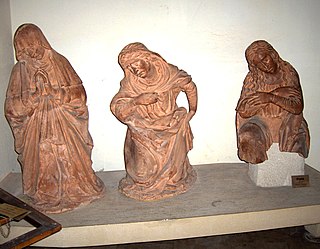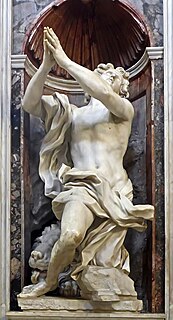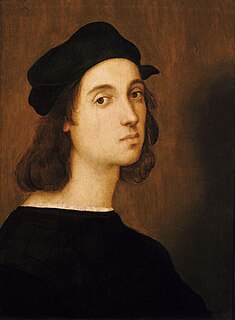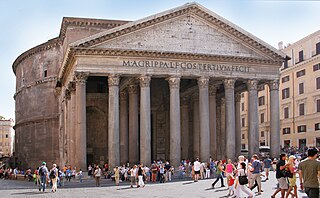
Michelangelo di Lodovico Buonarroti Simoni or more commonly known by his first name Michelangelo was an Italian sculptor, painter, architect and poet of the High Renaissance born in the Republic of Florence, who exerted an unparalleled influence on the development of Western art. Considered by many the greatest artist of his lifetime, and by some the greatest artist of all time, his artistic versatility was of such a high order that he is often considered a contender for the title of the archetypal Renaissance man, along with his rival, the fellow Florentine and client of the Medici, Leonardo da Vinci.

The Mausoleum of Hadrian, usually known as Castel Sant'Angelo, is a towering cylindrical building in Parco Adriano, Rome, Italy. It was initially commissioned by the Roman Emperor Hadrian as a mausoleum for himself and his family. The building was later used by the popes as a fortress and castle, and is now a museum. The structure was once the tallest building in Rome.

Andrea dal Monte Sansovino or Andrea Contucci del Monte San Savino was an Italian sculptor active during the High Renaissance. His pupils include Jacopo Sansovino.

Il Sodoma was the name given to the Italian Renaissance painter Giovanni Antonio Bazzi. Il Sodoma painted in a manner that superimposed the High Renaissance style of early 16th-century Rome onto the traditions of the provincial Sienese school; he spent the bulk of his professional life in Siena, with two periods in Rome.

The Parish Basilica of Santa Maria del Popolo is a titular church and a minor basilica in Rome run by the Augustinian order. It stands on the north side of Piazza del Popolo, one of the most famous squares in the city. The church is hemmed in between the Pincian Hill and Porta del Popolo, one of the gates in the Aurelian Wall as well as the starting point of Via Flaminia, the most important route from the north. Its location made the basilica the first church for the majority of travellers entering the city. The church contains works by several famous artists, such as Raphael, Gian Lorenzo Bernini, Caravaggio, Alessandro Algardi, Pinturicchio, Andrea Bregno, Guillaume de Marcillat and Donato Bramante.

Girolamo Genga was an Italian painter and architect of the late Renaissance, Mannerist style.

Christ Falling on the Way to Calvary, also known as Lo Spasimo or Il Spasimo di Sicilia, is a painting by the Italian High Renaissance painter Raphael, of c. 1514–16, now in the Museo del Prado in Madrid. It is an important work for the development of his style.

Baccio da Montelupo, born Bartolomeo di Giovanni d'Astore dei Sinibaldi, was a sculptor of the Italian Renaissance. He is the father of another Italian sculptor, Raffaello da Montelupo. Both father and son are profiled in Vasari's Le Vite delle più eccellenti pittori, scultori, ed architettori.

The Lives of the Most Excellent Painters, Sculptors, and Architects, also known as The Lives, is a series of artist biographies written by 16th-century Italian painter and architect Giorgio Vasari, which is considered "perhaps the most famous, and even today the most-read work of the older literature of art", "some of the Italian Renaissance's most influential writing on art", and "the first important book on art history". The title is often abridged to just the Vite or the Lives.
Nanni di Baccio Bigio, a pseudonym of Giovanni Lippi, was an Italian architect of the 16th century.

The statue of Jonah and the whale is a marble sculpture by Lorenzetto in the niche to the left of the altar in the Chigi Chapel, the Basilica of Santa Maria del Popolo, Rome. The sculptor followed the original designs of his mentor, Raphael, who was the architect of the chapel. This is the only sculpture that Raphael himself designed and was executed according to his intentions.

The statue of Elijah is a marble sculpture by Lorenzetto in the niche to the right of the entrance in the Chigi Chapel, the Basilica of Santa Maria del Popolo, Rome. The sculptor followed the original designs of his mentor, Raphael, who was the architect of the chapel. The statue was finished by his pupil, Raffaello da Montelupo.

Daniel and the Lion is a sculpture created by Gian Lorenzo Bernini c. 1655-57. Standing in a niche in the Chigi Chapel in the Basilica of Santa Maria del Popolo in Rome, it shows the Prophet Daniel in the lions' den. It forms a part of a larger composition with the sculpture of Habakkuk and the Angel diagonally opposite.

Habakkuk and the Angel is a sculpture created by Gian Lorenzo Bernini c. 1656-61. Standing in a niche in the Chigi Chapel in the Basilica of Santa Maria del Popolo in Rome, it shows the Prophet Habakkuk with the angel of God. It forms a part of a larger composition with the sculpture of Daniel and the Lion diagonally opposite.

The Altoviti are a prominent noble family of Florence.





















